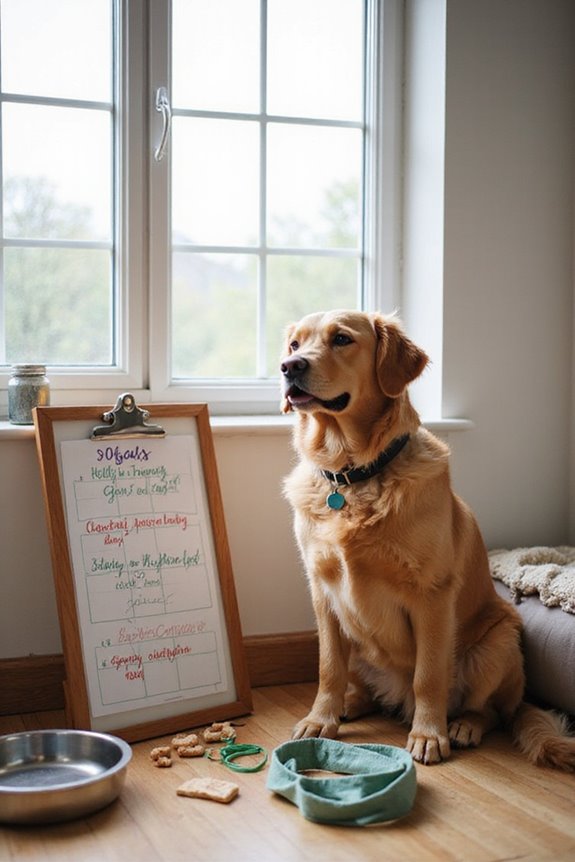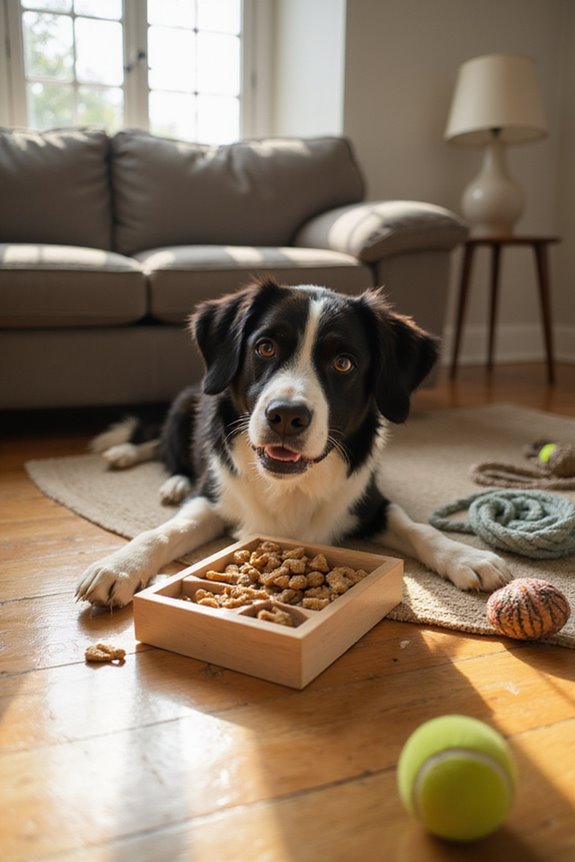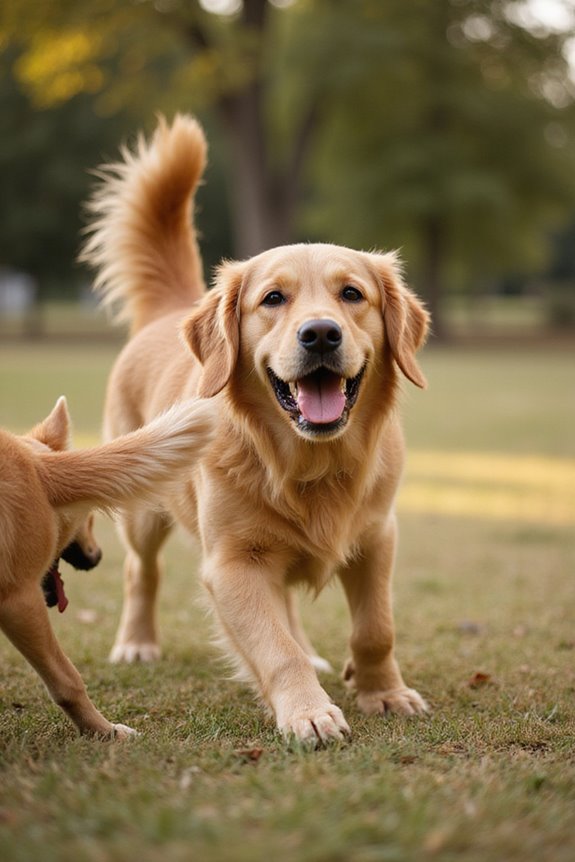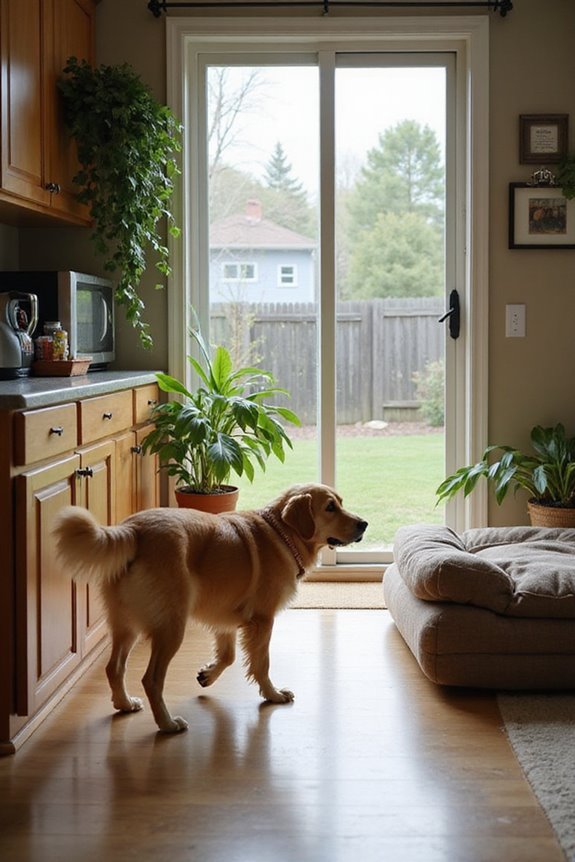To benefit your dog this New Year, consider a variety of resolutions. Focus on their health with regular veterinary check-ups, a balanced diet, and daily exercise. Behavioral goals, like reward-based training and socialization, enhance emotional well-being. Engaging your dog mentally through puzzles and scent work boosts cognitive skills. Ensuring safety at home and creating a comfortable environment is essential. By monitoring progress and making adjustments, you greatly improve your dog’s quality of life. More insights follow.
Key Takeaways
- Commit to regular veterinary check-ups to monitor health and catch potential issues early.
- Incorporate a balanced diet and appropriate exercise routine to maintain optimal weight and fitness.
- Engage in consistent training sessions using positive reinforcement to enhance obedience and behavioral skills.
- Provide mental enrichment through brain games and scent work to stimulate cognitive development and reduce stress.
- Encourage socialization with other dogs and people to improve emotional health and reduce behavioral problems.
Health and Wellness Resolutions
When it comes to your dog’s health and wellness, making thoughtful resolutions can lead to significant improvements in their quality of life. Start by committing to regular preventive care. Schedule annual veterinary exams for health monitoring, ensuring vaccinations are up-to-date. Focus on nutrition balance; measure food portions to prevent obesity and shift to high-quality diets aligned with your dog’s age and needs. Establish a daily exercise routine of at least 30 minutes, tailored to your dog’s breed and health status. Don’t overlook dental hygiene; regular check-ups can prevent periodontal disease. Create a grooming schedule, including nail trims and ear checks, and stay diligent with parasite prevention to maintain overall well-being. These practices are essential for your dog’s happiness and longevity. Additionally, consider incorporating joint supplements into your dog’s routine to support their mobility and overall joint health as they age.
Behavior and Training Goals

Setting clear behavior and training goals for your dog can greatly enhance their overall wellbeing and strengthen the bond you share.
- Behavioral Assessments: Regular evaluations help identify specific issues such as aggression, anxiety, or hyperactivity. Early intervention is essential.
- Training Techniques: I recommend using reward-based methods, which are scientifically proven to be more effective than aversive techniques. Positive reinforcement fosters a better emotional state, enabling your dog to learn more effectively.
- Measurable Goals: Set realistic objectives, like aiming for a Canine Good Citizen certification. Consistency in practice is key; weekly training sessions can notably improve obedience. Additionally, incorporating short training sessions can help prevent overwhelm and maintain your dog’s engagement.
Mental Stimulation and Enrichment

Enhancing your dog’s quality of life goes beyond behavioral training; it involves incorporating mental stimulation and enrichment into their daily routine. Engaging your dog in cognitive enrichment activities not only fosters mental sharpness but also reduces behavioral issues. Here are a few ways to achieve this:
- Brain Games: Interactive puzzles can enhance problem-solving skills by 60%. Regular participation decreases stress levels considerably, promoting peace of mind. Interactive puzzle toys are excellent tools for this purpose, as they encourage engagement and cognitive development.
- Scent Work: This taps into your dog’s natural tracking instincts. Activities like treat searches fulfill their olfactory needs and help reduce aggression by 50%.
- Training Games: Incorporating advanced commands boosts confidence and cognitive engagement, while also promoting impulse control.
Socialization and Emotional Well-being

Socialization is a crucial component in fostering a dog’s emotional well-being, as it enables them to develop essential social skills necessary for maneuvering their environment. Engaging your dog with other dogs and people can greatly enhance their emotional health. Studies show that socialized dogs are happier, with 55% of owners noticing an uplift in their pets’ moods post-interaction. By improving their social skills, dogs communicate better and encounter fewer behavioral issues. Regular social contact alleviates loneliness and reduces anxiety, which is essential for emotional stability. Additionally, early socialization leads to a 60% decrease in behavioral problems later in life. Prioritizing socialization guarantees your dog lives a happier, more balanced life, fostering lifelong emotional resilience and confidence.
Safety and Environment Adjustments

When guaranteeing your dog’s safety at home, it’s essential to reflect on both indoor and outdoor environments for potential hazards. Indoor safety begins with removing toxic plants, securing electrical cords, and storing chemicals out of reach. It’s vital to provide a comfortable indoor temperature, protecting your dog from extreme weather.
For outdoor security, verify your yard is fenced securely, regularly inspecting for weak points. Dogs should not be left unsupervised for long periods, reducing the risk of escape. Establish designated toilet areas to maintain consistency. Additionally, provide shade and fresh water to keep them safe during warm weather. Consider using a sturdy dog fence to enhance the safety of your outdoor space.
Routine and Consistency Enhancements
Establishing a structured routine for your dog is essential, as it not only promotes their well-being but also facilitates effective training and behavior management. The routine benefits encompass:
- Consistent Commands: Using the same cues for behaviors enhances understanding.
- Predictable Environment: A daily, set schedule helps lower anxiety.
- Behavioral Reinforcement: Positive reinforcement during structured training cements desired behaviors.
- Stress Reduction: Routine can decrease stress-related behaviors by up to 40%.
- Trust Building: A consistent approach fosters a secure bond and aids training progress.
- Communication Clarity: Clear expectations minimize frustrations and misunderstandings.
- Additionally, incorporating activities such as puzzle feeders can enhance mental stimulation and provide an engaging challenge during mealtime.
Quality Time and Bonding Activities
Quality time with your dog is essential, as it not only enhances your bond but also contributes greatly to both your emotional well-being and that of your pet. Engaging in bonding activities, even for just ten minutes, can uplift your spirits and improve mental health. Here are some effective ways to spend quality time:
- Jogging or Walking: Nearly 59% of owners enjoy outdoor activities with their dogs, promoting physical fitness for both.
- Driving Together: This allows your dog to experience new scenes, strengthening your connection. Ensuring safety features in your dog car seat during these trips is crucial for their well-being.
- Errands or Outings: About 27% of owners integrate their dogs into daily routines, fostering companionship.
- Dog-friendly Locations: Visiting restaurants or workplaces helps create social bonding experiences.
These activities not only enrich your life but also support your dog’s emotional needs.
Monitoring Progress and Adjusting Goals
Monitoring your dog’s training progress is crucial, not only for identifying effective methods but also for recognizing challenges that may arise during the learning process. Progress tracking is essential, as it allows me to pinpoint hidden behavioral issues and adjust my training strategies accordingly. I recommend maintaining a daily diary that captures successes and setbacks, which provides granular insights into our journey. Additionally, I find creating a ranked wish list of behavioral goals helps focus our training efforts. As I monitor progress, goal adjustment becomes necessary; recalibrating objectives guarantees they remain realistic and attainable. Using structured trackers simplifies the process, making it easier to celebrate achievements and identify areas that need more attention, ultimately refining our training approach.
Frequently Asked Questions
Can I Involve My Dog in My Fitness Resolutions?
Absolutely, I can involve my dog in my fitness resolutions! Dog exercise makes achieving fitness goals more enjoyable and rewarding. Plus, it strengthens our bond while ensuring we both stay healthy and active together.
How Can I Keep My Dog Entertained While I’m Busy?
I understand how tough it can be to keep your pup entertained while you’re busy. I love using interactive toys and puzzle games; they engage my dog’s mind and keep him happily occupied for hours.
Should I Hire a Professional Trainer or Trainer My Dog Myself?
Deciding between professional training and self-training techniques feels like choosing between a cozy blanket and a warm hug. I’d recommend professional training for expert guidance, but self-training builds our bond—I love the journey together!
What Are Some Dog-Friendly Activities for Winter?
When winter hits, I love taking my dog on cozy winter walks and engaging in indoor games. It’s a perfect way for us to bond while keeping our spirits up during the colder months.
How Can I Track My Dog’s Health Progress Effectively?
To track my dog’s health progress effectively, I keep health journals and use progress charts. It really helps me monitor changes, ensuring my furry friend stays happy and healthy every step of the way.




